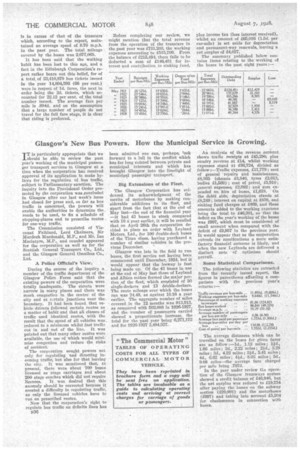Glasgow's New Bus Powers. How the Municipal Service is Growing.
Page 54

If you've noticed an error in this article please click here to report it so we can fix it.
IT is particularly appropriate that we should be able to review the past year's working of the municipal passenger transport services in Glasgow at a time when the corporation lute received approval of its application to make bylaws for the regulation of bus traffic, subject to Parliamentary sanction. The inquiry into the Provisional Order promoted by the corporation was ,concluded in Glasgow after our last week's issue had closed for press and, 80 far as bus traffic is concerned, the powers will enable the authorities to determine the roads to be used, to fix a schedule of stopping-places and to prescribe routes , for one-way traffic.
The Commission consisted of Viscount Falkland, Lord Chalmers, Sir Murdoch Macdonald, M.P., and Mr. Ian Maeintyre, and counkel appeared for the corporation as well as for the Scottish General Transport Co., Ltd., and the Glasgow General Omnibus Co., Ltd.
A Police Official's View.
During the course of the inquiry a member of the traffic department of the Glasgow Police Force said that the existing powers of the corporation were totally inadequate. The streets were narrow in many places and there was much congestion in the centre of the city and at certain junctions near the boundary. It had been found that vehicle drivers followed certain routes as a matter of habit and that all classes of traffic used identical routes, with the result that the speed of all vehicles was. reduced to a minimum whilst fast traffic cut in and out of the line. It was pointed out that many other routes were available, the use of which would minimise congestion and reduce the risks of accident.
The corporation sought powers noi only for regulating and directing incoming traffic, but also for that leaving the city. It was mentioned that, at present, there were about 700 buses licensed as stage carriages and about 200 stage coaches which did not require licences. It was desired that this anomaly should be corrected because it created a difficulty in regulating traffic, as only the licensed vehicles have to run on prescribed routes.
Now that the corporation's right to regulate bus traffic on definite lines has been admitted one can, perhaps, look forward to a lull in the conflict which has for long existed between private and municipal interests and which has brought Glasgow into the limelight of municipal passenger transport.
Big Extensions of the Fleet.
The Glasgow Corporation has evidenced its acknowledgment of the merits of motorbuses by making considerable additions to its fleet, and apart from the fact that at the end of May last-the end of the financial year -it had 43 buses in stock compared with 16 a year earlier, it will be recalled that.. on April 26th the corporation decided to place an order with Leyland Motors, Ltd., for 100 double-deck buses of the Titan class, having purchased a number of similar vehicles in the pre vious December. '
Glasgow was late in the field to run buses, the first service not having been commenced until December, 1924, but it would appear that the leeway is fast being made up. Of the 43 buses in use at the end of May last those of Leyland and Albion makes formed the major portion of the fleet, which consisted of 30 single-deckers and 13 dduble-deckers. The route mileage over which the buses ran was 24.49, as against 10.16 a year earlier. The aggregate number of miles covered in the 12 months 'was 913,913, as compared with 502,088 in 1926-1927, and the number of passengers carried showed a proportionate increase, the total for the past year being 0,271,172 and for 1926-1927 3,494,527. An analysis of the revenue account shows traffic receipts at £45,290, plus sundry revenue at £14, whilst working expenses stand at £36,724, divided as follow :-Traffic expenses, £17,779; cost of general repairs and maintenance, £8,365 (chassis £3,840, tyres £2,013, bodies 11,569) ; cost of petrol, £5,910; general expenses, £2,992; and sum expended on hire of buses, £1,678. On the debit side; depreciation stands at £8,249; interest on capital at £859, and sinking fund charges at £469, and these amounts added to the working expenses bring the total to £46,301, so that the deficit on the year's working of the buses was £997, which must be considered of small account when compared with the deficit of £9,957 in the previous year. It would appear that as the corporation extends its ramifications a more satisfactory financial outcome is likely, and when the new Leylands are delivered a distinct note of optimism should prevail.
Some Statistical Comparisons.
The following statistics are extracted from the recently issued report, the figures in parenthesee affording a comparison with the previous year's returns :
The average distances -which can be travelled on the buses for given fares are as follow :-1d., 1.12 miles;
1.66 miles ; 2d., 2.22 miles ; 2id., 3.28 miles ; 3d., 4.22 miles ; 30., 5.41 miles; 4d., 6.62 miles; 4id., 8.03 miles ;, 9.08 miles-the average faro charged per mile being .767d.
In the year under review the operation of the Glasgow tramways system showed a credit balance of 146,946, but the net surplus was reduced to 119,754 after paying the losses on the subway section (f20,991) and the motorbuses (i997) and taking into account £5,204 for obsolescence in connection with buses.




































































































